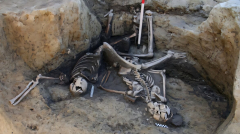
Get the Popular Science daily newsletter💡
Breakthroughs, discoveries, and DIY tips sent every weekday.
Among its many feats, Rome featured one of history’s most organized and successful military forces. Its organization and deployment helped solidify the empire’s centuries-long reign across the Mediterranean, Western Asia, North Africa, and Europe. In Croatia, archaeologists have discovered a mass grave dating back to the third century CE that indicates another key to Roman military strength: the diversity of its soldiers. Their findings are detailed in a study published in the journal PLOS One.
Researchers located the skeletal remains inside ancient water wells uncovered near Osijek, a city in eastern Croatia located about 10 miles from the Serbian border. Under Roman occupation 2,000 years ago, Osijek was known as Mursa. Beginning around 235 CE, Rome entered a period known as the Crisis of the Third Century. For almost 50 years, the empire existed as three separate warring polities and nearly collapsed entirely due to economic, political, and military strains. Historical records indicate Mursa was the site of one of this era’s many bloody skirmishes around 260 CE.
In 2011, excavation work yielded the complete, preserved skeletons of seven adult males in a water well converted into a mass grave. Subsequent bioarchaeological examinations including radiocarbon analysis indicated the bodies date back to the second half of the third century. The men ranged in age from 18 to 50, and all displayed fatal injuries including puncture wounds, rib fractures,





